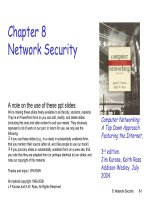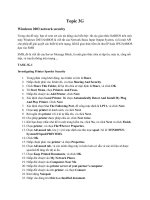09 security updated
Bạn đang xem bản rút gọn của tài liệu. Xem và tải ngay bản đầy đủ của tài liệu tại đây (16.55 MB, 22 trang )
Electronic Commerce
Chapter6:Systemsecurity
Email:
Objectives
• Security requirements
• Authentication
• Access control
Securityrequirements
•
•
•
•
Confidentiality
Integrity
Availability
Non-repudiation
Policyandmechanism
• Need to have a security policy and appropriate security
mechanism
• A security policy is a statement of what is, and what is not,
allowed
• A security mechanism is a method, tool, or procedure for
enforcing a security policy
• A security mechanism can implement a policy by
• Prevent the attack
• Detect the attack
• Recover from the attack
• In designing policy, need to identify threat
• A threat is a potential violation of security
Securitythreats
• Type of threats
•
•
•
•
Disclosure: unauthorized access to information
Deception: acceptance of false data
Disruption: interruption or prevention of correct operation
Usurpation: unauthorized control of some part of a system
• The security life cycle
Commonattacks
• Snooping: unauthorized interception of information, is a form
of disclosure
• Passive
• Passive wiretapping: snooping happen on a network
• Modification (or alteration): deception, disruption, and
usurpation
• Active
• Active wiretapping: modification happen on a network
• Example: man-in-the-middle attack
Commonattacks
• Masquerading (or spoofing): impersonation of one entity by
another, is a form of deception, and usurpation
• Passive or active
• Repudiation of origin: false denial that an entity sent
something, is a form of deception
• Active
• Denial of service: long-term inhibition of service, is a form of
usurpation
• Active
• May happen at the source, the destination, or the
communication path
Commonattacks
• Malicious code: is a set of instructions that cause a site's
security policy to be violated
• Trojan horse: is a program with an overt (documented or
known) effect and a covert (undocumented or unexpected)
effect
• Example: this UNIX script is named ls, what does it do?
•
•
•
•
cp /bin/sh /tmp/.xxsh
chmod o+s,w+x /tmp/.xxsh
rm ./ls
ls $*
Commonattacks
• Computer virus: is a program that inserts itself into one or
more files and then performs some actions
• A boot sector infector is a virus that inserts itself into the
boot sector of a disk
• An executable infector is a virus that infects executable
programs
• An encrypted virus is one that enciphers all of the virus
code except for a small decryption routine
• A polymorphic virus is a virus that changes its form each
time it inserts itself into another program
• A macro virus is a virus composed of a sequence of
instructions that is interpreted, rather than executed
directly
Commonattacks
• Computer worm: is a program that copies itself from one
computer to another
• Defense: multilevel strategy
•
•
•
•
•
•
•
1. Written policies and procedures.
2. User awareness and education.
3. Physical security.
4. Product selection, configuration, and maintenance.
5. Password management.
6. Anti-virus software for servers, clients, and electronic mail.
7. Adequate system backups.
Authentication
• Authentication is the process of verifying the identity a subject
claims it to be
• The subject must provide information to enable the system to
confirm its identity
•
•
•
•
Something the subject knows
Something the subject has
Something the subject is
Combination of them
• Authentication mechanism
•
•
•
•
Password
Challenge-response
Biometrics
Multi-factor
Authentication
• Password
• Based on “something the subject knows”
• The subject supplies a password, and the system verifies it
against the stored database
• How to keep the passwords secret even from the administrators?
=> using a one-way hash function
• Attacks on password systems
• Dictionary attack: trial and error, using a list of possible
passwords
• Brute force attack: trying every possible passwords
• Rainbow table: pre-computed table for reversing cryptographic
hash functions
Authentication
• Defending the password system
• Users need to use “good” password
• Theorem: let the expected time required to guess a password be
T, then T is maximum when the selection of any of a set of
possible passwords is equals
• Random computer-generated passwords: strong, but difficult for
human users
• Pronounceable computer-generated passwords: compromise
between passwords selected by users and generated by
computer randomly
• Password aging: a password must be changed after some period
of time or after some event has occurred
Authentication
• Challenge-response
• The fundamental problem with password: reusable
• Idea: using passwords that change each time it is used
• Challenge-response authentication:
• Server and user agree on a function f
• Server sends a random message m (the challenge) to user, and user
replies with the transformation r = f(m) (the response). Server
validates r by computing it separately
• This is a form of one-time password
• Also based on “something the subject knows”
Authentication
• Challenge-response example: CAPTCHA (Completely
Automated Public Turing test to tell Computers and Humans
Apart)
• Challenge-response authentication (that you are human)
• What is challenge, what is response?
• Easy for authenticated subjects (human) but difficult for
unauthenticated ones: is that assumption still valid now?
Authentication
• Types of Captcha
• Attacks on Captcha system
• Blind guessing
• AI attacks
• Relay attacks: Man in the middle, outsourcing, collusion attacks
Authentication
• Biometrics
• The automated measurement of biological or behavioral features
that identify a person
• Based on “something the subject is”
• Many features can be used
•
•
•
•
•
Fingerprints
Voice
Face
Keystroke
Gesture
• Problems
• Noisy data
• Not easy to change once be stolen
• Availability
Authentication
• Multi-factor
• Using more than one way to authenticate a subject
• Providing more layers of protection
• But not convenient for users
• How to design an authentication system?
• =>Using the security life cycle
Accesscontrol
• Access control: exerting control over who can interact with a
resource
• Types of access control
• Discretionary access control (DAC): a subject with a certain access
permission is capable of passing that permission on to any other
subject
• Mandatory access control: the operating system constrains the
ability of a subject to access an object
• Access control presentation
• Access control matrix
• Objects: columns
• Subjects: rows
• Access permission: respected cells
Accesscontrol
File 1
File 2
Process 1
Process 1
Read, own
Write
Own
Process 2
Append
Own, write
Execute
Process 2
Own
◦ Access control list:
◦ There is a list of subjects and their permissions on a
particular object
◦ Example: acl(file 1) = { (Process 1, { read, own }),
(Process 2, { append }) }
◦ Capabilities list:
◦ There is a list of objects and what can be done on
them for a particular subject
◦ Example: cap(Process 1) = { (File 1, { read, own }),
(file 2, { write
◦ }), (process 1, {own}), }
Accesscontrol
• Bell-LaPadula model
• Subjects have security clearance: TS (top secret), S (secret), C
(confidential), UC (unclassified) (ls)
• Object have security classification: the same as above (lo)
• Simple security condition: subject can read object if and only if lo
<= ls
• Star property: subject can write to object if and only if ls <= lo
Endofchapter6









